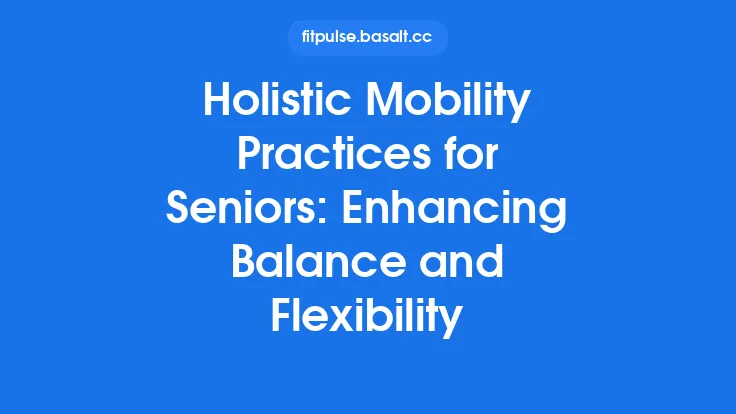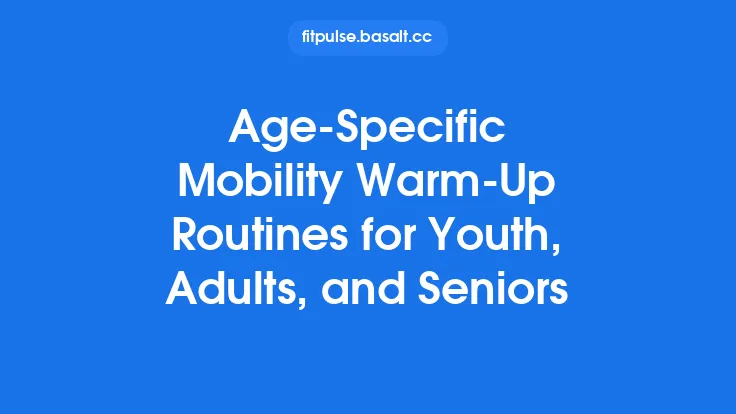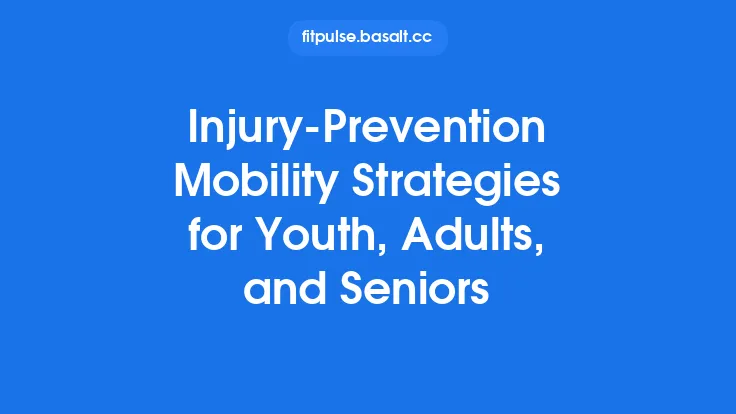Gentle Pilates offers a uniquely balanced approach for seniors who experience limited mobility, weaving together controlled movement, focused breathing, and mindful awareness. By emphasizing precision over intensity, this practice nurtures both physical resilience and mental clarity, making it an ideal home‑based solution for older adults seeking a safe, low‑impact way to stay active. Below, we explore the foundational concepts, practical adaptations, and holistic benefits of integrating Pilates into a senior’s daily routine, all while respecting the constraints of limited joint range and strength.
Understanding the Core Principles of Pilates for Seniors
Pilates was originally devised to rehabilitate injured dancers, and its core tenets translate seamlessly to senior fitness:
- Centering (Centripetal Control) – All movement originates from the deep abdominal and lumbar muscles, often referred to as the “powerhouse.” For seniors, strengthening this central region improves spinal stability, reduces the risk of falls, and supports everyday tasks such as standing from a chair or reaching for objects.
- Concentration – Each exercise demands full mental presence. By directing attention to subtle cues—like the engagement of the transverse abdominis or the alignment of the pelvis—practitioners develop a heightened body‑mind connection that can offset age‑related declines in proprioception.
- Control – Movements are performed deliberately, avoiding momentum. This principle is crucial for those with limited mobility, as it minimizes joint stress and encourages safe, joint‑friendly ranges of motion.
- Precision – Small, accurate adjustments are emphasized over large, sweeping motions. Precision helps seniors achieve functional improvements without over‑loading fragile tissues.
- Breath – Coordinated breathing patterns synchronize with movement, fostering relaxation, oxygenation of muscles, and mental focus.
- Flow – Exercises transition smoothly, promoting fluidity and reducing abrupt stresses on joints.
When these principles are applied with senior‑specific modifications, Pilates becomes a mind‑body discipline that respects the body’s current capabilities while gently encouraging progress.
Adapting Pilates Movements for Limited Mobility
The hallmark of senior‑friendly Pilates is modification. Below are common adaptations that preserve the essence of each exercise while accommodating reduced range of motion, balance challenges, or joint pain.
| Traditional Exercise | Senior‑Friendly Adaptation | Key Focus |
|---|---|---|
| The Hundred (lying on back, arms pumping) | Perform the arm pumps while seated on a sturdy chair, legs bent at 90°, feet flat on the floor. Keep the torso upright and engage the core as you inhale for five counts, exhale for five. | Core activation, breath coordination |
| Roll‑Up (spine articulation from supine to seated) | Use a rolled towel or small pillow under the head for support, and limit the roll to a half‑curl, stopping when the shoulders are comfortably off the mat. | Spinal articulation, abdominal control |
| Single‑Leg Stretch | Keep both feet on the floor, gently lift one knee a few inches while maintaining a neutral spine, then switch sides. Use a small pillow under the lower back if needed. | Hip flexor activation, core stability |
| Side‑Leg Series | Perform the movement while seated, extending one leg to the side and returning, using a resistance band for added cue if desired. | Hip abductor strengthening, balance preparation |
| Spine Twist | Sit upright with a small ball or cushion between the knees to maintain alignment, rotate gently to each side, keeping the shoulders relaxed. | Thoracic mobility, rotational control |
General Guidelines for Adaptation
- Range of Motion (ROM) First: Begin with the smallest comfortable ROM and gradually expand as confidence and flexibility improve.
- Supportive Props: Use cushions, rolled towels, or sturdy chairs to provide stability and reduce strain on joints.
- Reduced Repetitions: Start with 5–8 repetitions per side, focusing on quality rather than quantity.
- Tempo Control: Adopt a slow, deliberate tempo (e.g., 2 seconds up, 2 seconds down) to reinforce muscular control.
These adaptations ensure that the Pilates session remains safe, effective, and enjoyable for seniors with limited mobility.
Breathing Techniques: The Bridge Between Mind and Body
Breathing in Pilates is not merely a physiological necessity; it is a conduit for mental focus and muscular coordination. Two primary breathing patterns are especially beneficial for seniors:
- Lateral Thoracic Breathing (also called “rib‑cage breathing”)
- How to Perform: Inhale through the nose, expanding the ribs laterally while keeping the abdomen relatively still. Imagine the ribs opening like a book.
- Why It Helps: This pattern encourages full lung expansion, improves oxygen delivery, and reduces the tendency to hold the breath during core engagement—a common issue that can increase intra‑abdominal pressure and discomfort.
- Coordinated Breath‑Movement Cue
- Inhale during preparatory phases (e.g., when lengthening the spine or setting up a position).
- Exhale during the execution phase (e.g., when drawing the belly button toward the spine or lifting a limb).
- Benefits: Aligning breath with movement reinforces the mind‑body link, promotes relaxation, and aids in maintaining a steady rhythm throughout the session.
Practical Exercise: Seated Breath Awareness
- Sit tall with feet flat, hands resting on the thighs. Inhale for a count of four, feeling the ribs expand sideways; pause briefly; exhale for a count of six, gently drawing the belly button toward the spine. Repeat for 5 cycles. This simple practice can be incorporated at the start and end of every Pilates routine to center the mind and prime the core.
Sequencing a Gentle Pilates Session at Home
A well‑structured session balances warm‑up, core work, mobility, and cool‑down, all while respecting the senior’s energy levels and joint health. Below is a sample 20‑minute sequence that can be performed on a mat or a firm carpet, using a sturdy chair for support when needed.
- Warm‑Up (3 minutes)
- Seated Breath Awareness (as described above) – 1 minute
- Neck Rolls – gently roll the head clockwise and counter‑clockwise, 5 repetitions each direction.
- Core Activation (5 minutes)
- Seated Hundred (Modified) – 2 sets of 30 arm pumps, focusing on deep abdominal engagement.
- Supine Pelvic Tilt – lie on back with knees bent, gently flatten the lower back into the mat on exhale, then release on inhale. 8 repetitions.
- Spinal Mobility (4 minutes)
- Cat‑Cow (Chair Version) – sit tall, inhale to arch the back (cow), exhale to round the spine (cat). 10 cycles.
- Seated Side Stretch – reach one arm overhead, gently lean to the opposite side, hold 3 breaths, switch sides. 4 repetitions each side.
- Hip & Leg Conditioning (5 minutes)
- Seated Single‑Leg Extension – extend one leg, hold for 2 breaths, lower; repeat 6 times each leg.
- Side‑Leg Series (Chair) – with a resistance band around the thighs, lift the leg laterally, control the return. 8 repetitions each side.
- Cool‑Down & Mindful Integration (3 minutes)
- Supine Spinal Twist (Modified) – knees bent, let them fall gently to one side while keeping shoulders grounded; hold 5 breaths, switch sides.
- Final Breath Awareness – return to seated position, perform 5 slow, deep breaths, visualizing the flow of energy through the body.
Customization Tips
- Time Flexibility: If fatigue sets in, reduce the session to 10–12 minutes, focusing on the core activation and breathing components.
- Progressive Load: Introduce a light resistance band or a small Pilates ball once the basic movements feel comfortable.
Equipment and Props: Enhancing Comfort and Support
While Pilates can be practiced with minimal gear, a few thoughtfully chosen props can dramatically improve safety and comfort for seniors with limited mobility.
| Prop | Purpose | Recommended Specifications |
|---|---|---|
| Sturdy Chair | Provides a stable base for seated exercises and balance support. | Seat height 16–18 in, no wheels, solid backrest. |
| Yoga Mat or Non‑Slip Pad | Cushions joints and prevents slipping during supine or prone work. | Thickness ¼–½ in, high‑density foam. |
| Rolled Towels / Small Bolsters | Supports the lumbar spine, neck, or under knees for gentle hip flexor release. | Length 12–18 in, firm yet compressible. |
| Resistance Bands (Light) | Adds gentle resistance for leg and arm work without overloading joints. | Light (≈ 2–3 lb tension) or extra‑light (≈ 1 lb). |
| Pilates Ring (Mini‑Loop) | Encourages coordinated activation of inner thigh and core muscles. | Diameter 10–12 in, light spring tension. |
| Soft Ball (e.g., Pilates ball, small therapy ball) | Facilitates gentle core engagement and proprioceptive feedback. | Diameter 6–8 in, deflated slightly for softness. |
Safety Note: Always inspect props for wear and tear before each session. Ensure the chair is placed on a non‑slippery surface and that the mat does not shift during movement.
Safety Considerations and Contraindications
Even gentle Pilates can pose risks if performed without proper awareness. Seniors should observe the following precautions:
- Medical Clearance: Individuals with uncontrolled hypertension, recent surgeries, severe osteoporosis, or acute joint inflammation should obtain physician approval before beginning.
- Joint Pain vs. Discomfort: Mild muscular fatigue is normal; sharp or lingering joint pain indicates an inappropriate range or technique and should prompt immediate cessation of the exercise.
- Neck Alignment: Avoid excessive cervical flexion or extension; keep the neck in neutral alignment, especially during supine movements.
- Breath Holding: Instruct participants to exhale during effort phases to prevent intra‑abdominal pressure spikes that could affect blood pressure.
- Balance Support: When standing transitions are required, keep a sturdy chair or countertop within reach.
- Progression Pace: Increase repetitions, range, or resistance no more than 10 % per week to allow connective tissues to adapt safely.
By adhering to these guidelines, seniors can enjoy the benefits of Pilates while minimizing injury risk.
Mental Benefits: Enhancing Focus, Mood, and Cognitive Function
The mind‑body nature of Pilates yields several psychological advantages that are especially valuable for older adults:
- Improved Attention and Executive Function
- The concentration required for precise movement cues stimulates the prefrontal cortex, supporting planning, decision‑making, and working memory. Studies have shown that regular mind‑body practices can modestly improve scores on cognitive assessments in seniors.
- Stress Reduction and Mood Elevation
- Coordinated breathing activates the parasympathetic nervous system, lowering cortisol levels and promoting a sense of calm. The rhythmic flow of Pilates also releases endorphins, contributing to a more positive mood.
- Body Awareness and Self‑Efficacy
- As seniors notice incremental improvements in posture, balance, and core strength, their confidence in daily activities grows. This heightened self‑efficacy can translate into greater willingness to engage in other physical and social pursuits.
- Mindful Presence
- Pilates encourages a “here‑and‑now” mindset, which can counteract age‑related tendencies toward rumination or anxiety about health decline.
Incorporating brief reflective moments—such as a final seated meditation focusing on breath and gratitude—can amplify these mental benefits.
Progression Strategies and Tracking Improvements
To sustain motivation and ensure continued development, seniors should adopt a structured yet flexible progression plan.
1. Objective Metrics
- Core Activation Rating: Use a simple 0–5 scale (0 = no engagement, 5 = strong, sustained activation) after each core exercise.
- Range of Motion (ROM) Benchmarks: Measure the distance a leg can be lifted or the angle of spinal flexion using a goniometer or visual estimate. Record weekly.
- Repetition Tolerance: Note the maximum comfortable repetitions for each exercise before fatigue sets in.
2. Subjective Measures
- Perceived Exertion: Apply the Borg Scale (6–20) after each session; aim for a rating of 9–11 (light to moderate).
- Mood Log: Briefly record mood before and after the session (e.g., “calm,” “energized,” “frustrated”).
3. Incremental Progression
- Week‑to‑Week Adjustments: Increase repetitions by 1–2, add a light band, or extend the range by a few degrees only when the previous level feels “easy” for three consecutive sessions.
- Micro‑Progressions: For example, transition from a seated arm pump to a seated arm pump with a small weight (½ lb) before moving to a standing version.
4. Review Cycle
- Conduct a brief review every four weeks, comparing recorded metrics. Celebrate any gains—no matter how modest—and adjust the program to address any plateaus (e.g., introduce a new variation or increase rest intervals).
This systematic approach keeps the practice purposeful and measurable without turning it into a high‑intensity regimen.
Integrating Pilates into Daily Life
Beyond formal sessions, the principles of Pilates can be woven into everyday activities, reinforcing mind‑body integration throughout the day.
- Postural Reminders: While watching television or reading, gently engage the deep abdominal muscles and align the shoulders, mirroring the “centered” Pilates posture.
- Micro‑Movements: Perform a seated pelvic tilt while waiting for the kettle to boil, or a brief side stretch while standing in line.
- Breath Integration: Use lateral thoracic breathing during routine tasks such as folding laundry or gardening, promoting oxygenation and calm.
- Functional Transfer: Apply the core engagement learned in Pilates when lifting groceries, opening a door, or getting up from a low chair, thereby reducing strain on the lower back.
By treating Pilates as a lifestyle philosophy rather than a discrete workout, seniors can reap continuous benefits without needing extended dedicated time blocks.
Tips for Sustaining a Mind‑Body Practice
- Create a Dedicated Space
- Even a small corner with a mat, chair, and a few props signals to the brain that it’s time for focused practice.
- Set Realistic Goals
- Aim for consistency (e.g., three 15‑minute sessions per week) rather than duration. Small, regular habits are more sustainable than occasional long sessions.
- Use Guided Resources
- Follow age‑appropriate video tutorials or audio cues that emphasize gentle pacing and clear breathing instructions.
- Partner Up
- Practicing with a friend, family member, or virtual group adds accountability and social enjoyment, which further supports mental health.
- Listen to the Body
- Adjust or skip movements that cause discomfort; the practice should feel nurturing, not punitive.
- Celebrate Milestones
- Mark achievements—such as holding a seated twist for a full minute or noticing improved posture—by noting them in a journal or sharing with a loved one.
- Stay Curious
- Periodically explore new Pilates variations or props to keep the routine fresh and engaging.
By embedding these strategies, seniors can maintain a lifelong mind‑body connection that supports both physical independence and emotional well‑being.
Gentle Pilates, when thoughtfully adapted, offers seniors a safe, empowering pathway to integrate movement, breath, and mindful awareness. Through consistent practice, older adults can enhance core stability, improve joint mobility, and nurture mental resilience—all within the comfort of their own homes. The result is not merely a workout, but a holistic habit that honors the body’s present capabilities while gently encouraging growth and vitality.





